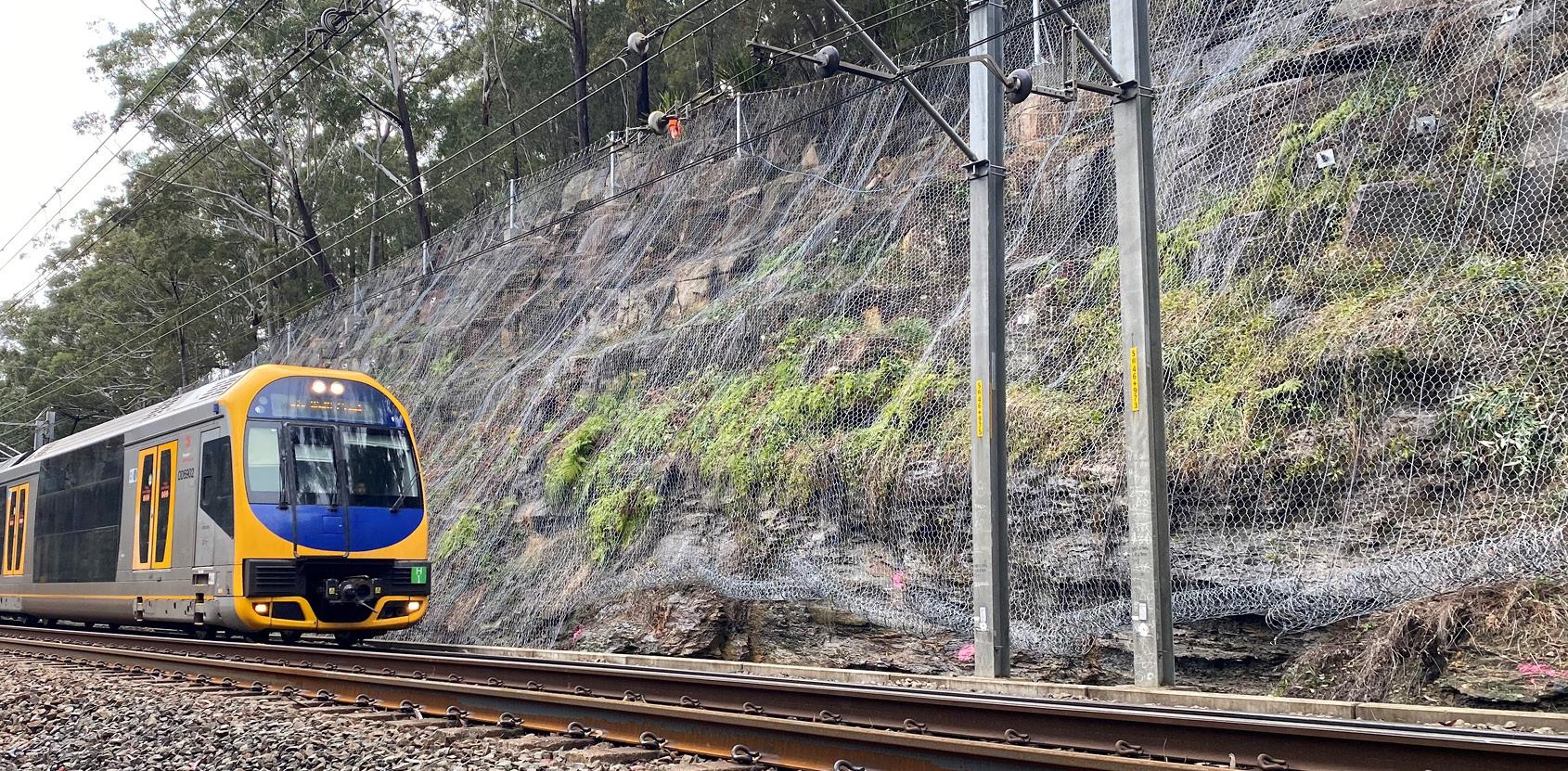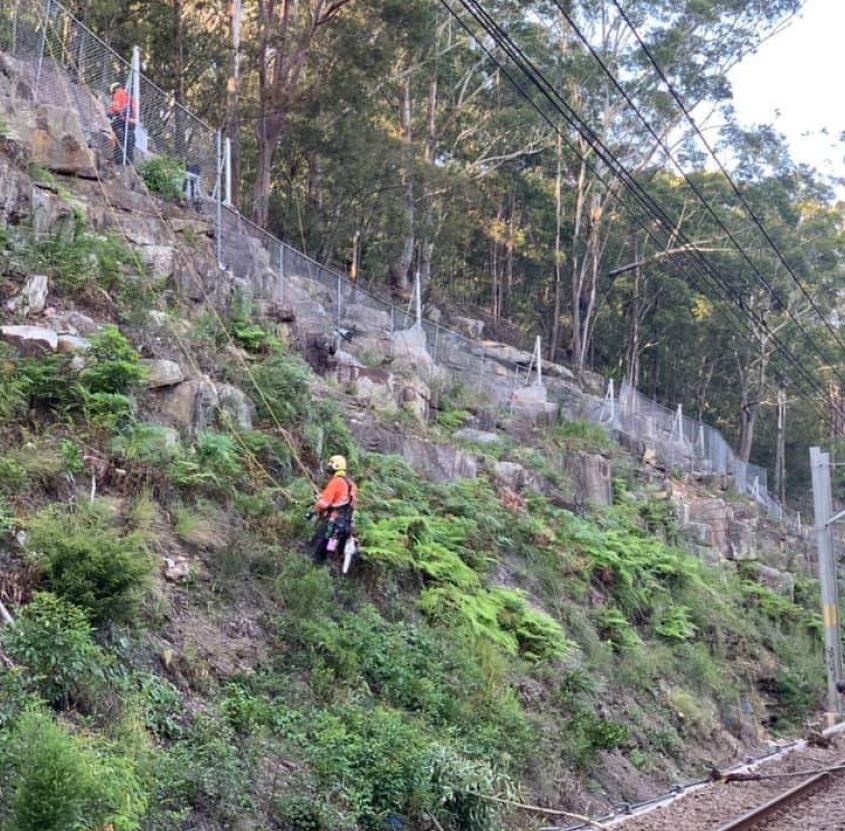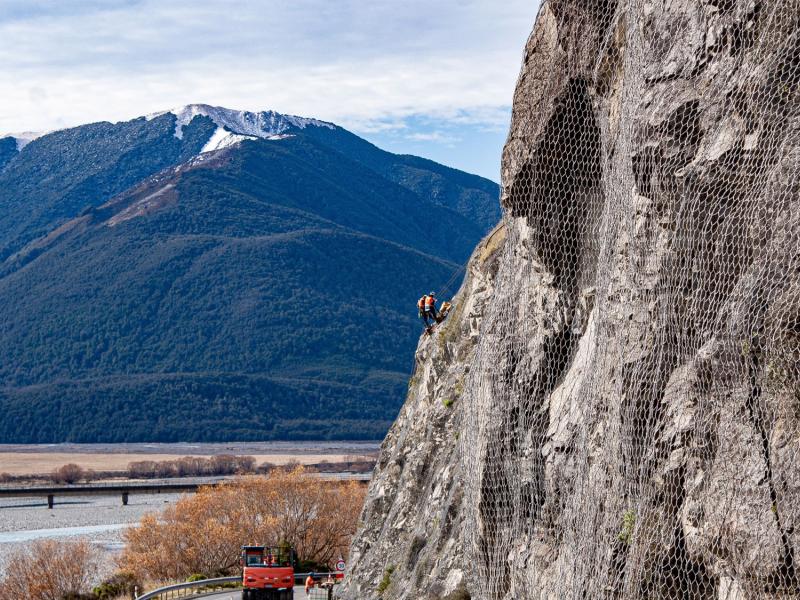
HELENSBURGH CUTTING HYBRID ROCKFALL BARRIER

PROJECT DESCRIPTION
Located in New South Wales, Australia, the Helensburgh rail line services nearly 900 people daily.
Due to slope instabilities along a section of the rail cutting between 46.740km and 47.170km, a rockfall solution was required for protection of the infrastructure and rail users should a rockfall event occur.
CHALLENGE
Many of the slope instabilities are associated with the presence of significantly large, fractured, or even detached rock boulders along the top edge of the cutting. The block features are likely to fail through sliding rather than bouncing.
The cutting is up to 16m high, with the top 4m being vertical, and below that roughly 45 degrees. There is a continuous flatter angled slope above. Hybrid barriers are typically constructed using an ETAG 027 rated rockfall barrier system with alterations made to the netting configuration to create a tail that can be draped over the ground downward of the structure.
Hybrid barriers are not designed to stop falling rocks where they are impacted, but to dissipate most of rockfall energy (up to 90%) and to guide the rock, with limited residual energy, to the toe of the slope. The best locations for hybrid fences are typically across gullies or at the crest of steep slopes with continuous flatter angled slopes above.
Currently hybrid fences do not have a universally accepted standard crash test like ETAG 027 (now EAD 340059-00- 0106) for rock fall catch fences, which is based on a free-falling block of known mass impacting the center span.
The issue with developing a test for hybrids/ attenuators is due to the repeatability and consistency of conducting them, ensuring the rocks will be impacting at the same location every time.
These are among the reasons why a standardised test is difficult to establish.
The Colorado Department of Transport has conducted attenuator fence tests with the primary objective of investigating the different types of intercepting panels and their ability to resist rotational energy type rock impacts, with the aim of reducing the long-term maintenance.
Some valuable data, such as impact time with the drape length tested, was recorded and provided some valuable lessons and experience that could be gained from this test.
Impact time is further attenuated compared to a standard catch fence and with the delayed time implies a reduction of impact force (anchor loadings, foundation loadings etc).
It can be concluded from this testing that the impact forces on hybrid fences can be half that of a standard catch fence due to the attenuation of impact duration.
OUR SOLUTION
Geofabrics supplied a bespoke Maccaferri hybrid rockfall barrier comprising of posts, anchors, steel wire rope, anchor plates, high performance mesh, and accessories.
At 422m, it is by far the longest one in Australia. Feruled loops were created in the factory at each end of the integral Steelgrid HR30 wire ropes.
This made attaching the Steelgrid to the top support rope a seamless procedure.
PRODUCTS USED
Maccaferri® Dynamic Rockfall Barriers/Catch Fence
- The system combines the energy absorption capabilities of a dynamic rockfall barrier with the reduced-maintenance advantages of drapery mesh
- It is typically used on slopes where there is available ‘run-out’ space beneath the barrier in which the rocks can ultimately stop or be collected safely
- Geofabrics offers a range of Maccaferri rockfall barrier fence systems designed to intercept falling rocks which have detached from the rock face above which may cause damage to infrastructure below and in severe cases loss of life
Maccaferri® Steelgrid® HR Rockfall Netting
- A high strength, high stiffness steel composite netting/drapery system combining the versatility and practical benefits of double twist mesh with the excellent stiffness and mechanical durability of high tensile steel wire ropes
- It can be used in both simple drapery or pinned drapery systems and in a variety of specialist geotechnical and engineering applications including slope stabilisation, rockfall protection and surface protection applications





